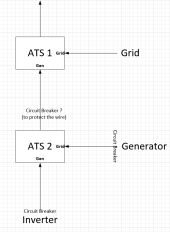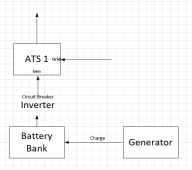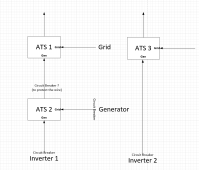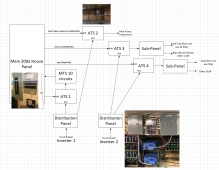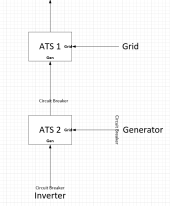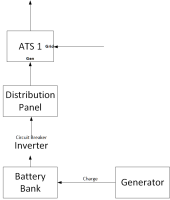Hi Everyone,
First post, been reading here for a few weeks and trying to learn. I'd like to do a small-scale DIY install this summer to get my feet wet. Wanted to solicit some pre-setup advice. Apologies if I give extraneous info, I'm just beginning with this. I'm in the U.S., so 120/240 AC power. The plan is a PV system charging 48V lithium batteries, grid-tied to charge the batteries (from grid or generator) when needed, but not back-feeding the grid. This is not meant to be a whole-house power replacement, but instead a gradual reduction of grid use and a way to reduce generator demand in case of extended outages.
Here's the situation: On my property there are 3 buildings with power: the house, a detached garage, and a shop building. Grid power comes on the property to the meter, and then splits off to the shop in one direction and then to the house in the other direction. At the meter a propane generator backs up everything. Both the shop and the house have their own electric panel (not in same location) each with a main breaker rated at 200amps. The garage is wired into the house main panel on a 30-amp breaker. There is no subpanel in the garage, just what looks to me to be DIY wiring of outlets for lights and 120V power. So:
garage <- house <- GRID -> shop
To my eye the shop roof is well-suited for solar; the building runs east to west and the one side of the roof is facing almost due south, with very little shading during the day. A key issue is also that the shop electric panel powers the well pump, which I definitely want to put on solar (I'll post begging for help with that later, once the clamp meter I ordered arrives and I can provide info on what it draws). Great: I can put the array on the roof and the inverter/chargers and batteries in the shop and power the well, but then what? Currently there's no way to send power from the shop to the house, so scaling larger than what's needed for the well pump and a chest freezer doesn't reduce the house consumption. For the house, there really isn't a convenient place for the inverters and batteries inside, so these would go in the garage. The breaker panel on the house is on the outside, about 35 feet the spot in the garage where I would locate the inverters/batteries.
The question I have here is: should the breaker panels be moved or the electric service from the grid meter re-routed to make things easier in the future? I'd have an electrician do this, of course. My thoughts were:
Option 1: From the grid meter, re-route the house service so that it goes to the shop first, with a panel which would allow it to be tied into the PV system before being sent to the house. This could also involve sending it from the shop to the garage for any PV system on the garage and house roofs. So: grid -> shop -> house, or grid -> shop -> garage -> house
Option 2: Leave main routing as is. Move house main breaker panel to garage, tie into garage/house PV system, and then send power back to house. Power from PV system on shop would then either just be for well pump, or PV power from shop would have to be sent to garage (~100feet) either as DC (expensive wires) or AC (loss on converting to AC and then back to DC for batteries).
Option 3: ?
Thanks for reading all of that, and appreciate any suggestions. I want to avoid building out the system only to find out in 3 years that I really should have addressed the power routing and main panel situation first.
First post, been reading here for a few weeks and trying to learn. I'd like to do a small-scale DIY install this summer to get my feet wet. Wanted to solicit some pre-setup advice. Apologies if I give extraneous info, I'm just beginning with this. I'm in the U.S., so 120/240 AC power. The plan is a PV system charging 48V lithium batteries, grid-tied to charge the batteries (from grid or generator) when needed, but not back-feeding the grid. This is not meant to be a whole-house power replacement, but instead a gradual reduction of grid use and a way to reduce generator demand in case of extended outages.
Here's the situation: On my property there are 3 buildings with power: the house, a detached garage, and a shop building. Grid power comes on the property to the meter, and then splits off to the shop in one direction and then to the house in the other direction. At the meter a propane generator backs up everything. Both the shop and the house have their own electric panel (not in same location) each with a main breaker rated at 200amps. The garage is wired into the house main panel on a 30-amp breaker. There is no subpanel in the garage, just what looks to me to be DIY wiring of outlets for lights and 120V power. So:
garage <- house <- GRID -> shop
To my eye the shop roof is well-suited for solar; the building runs east to west and the one side of the roof is facing almost due south, with very little shading during the day. A key issue is also that the shop electric panel powers the well pump, which I definitely want to put on solar (I'll post begging for help with that later, once the clamp meter I ordered arrives and I can provide info on what it draws). Great: I can put the array on the roof and the inverter/chargers and batteries in the shop and power the well, but then what? Currently there's no way to send power from the shop to the house, so scaling larger than what's needed for the well pump and a chest freezer doesn't reduce the house consumption. For the house, there really isn't a convenient place for the inverters and batteries inside, so these would go in the garage. The breaker panel on the house is on the outside, about 35 feet the spot in the garage where I would locate the inverters/batteries.
The question I have here is: should the breaker panels be moved or the electric service from the grid meter re-routed to make things easier in the future? I'd have an electrician do this, of course. My thoughts were:
Option 1: From the grid meter, re-route the house service so that it goes to the shop first, with a panel which would allow it to be tied into the PV system before being sent to the house. This could also involve sending it from the shop to the garage for any PV system on the garage and house roofs. So: grid -> shop -> house, or grid -> shop -> garage -> house
Option 2: Leave main routing as is. Move house main breaker panel to garage, tie into garage/house PV system, and then send power back to house. Power from PV system on shop would then either just be for well pump, or PV power from shop would have to be sent to garage (~100feet) either as DC (expensive wires) or AC (loss on converting to AC and then back to DC for batteries).
Option 3: ?
Thanks for reading all of that, and appreciate any suggestions. I want to avoid building out the system only to find out in 3 years that I really should have addressed the power routing and main panel situation first.



